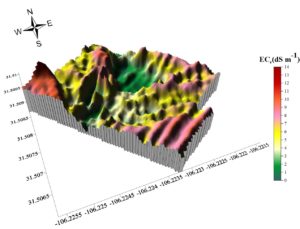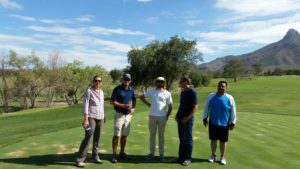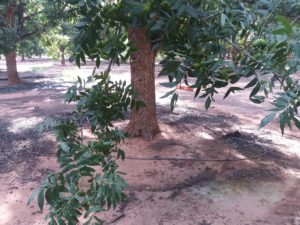Summary
Current Research
- Evaluation of Sulfur Burner for Salinity Management in Irrigated Cotton Fields in Far West Texas.
- Salinity Assessment and Management at Coronado Country Club Golf Course
- Diversifying the Water Portfolio for Agriculture in the Rio Grande Basin
- Sustainable Water Resources for Irrigated Agriculture in a Desert River Basin facing Climate Change and Competing Demands.
The Water Resources and Salinity Management research program specializes in:
- Salinity assessment and management
- Beneficial use of waters with elevated salinity such as industrial wastewater, gray-water, reclaimed water, and brackish groundwater
- On-farm water conservation.
Current research includes developing strategies for potential climate change impacts on water and salinity and developing alternative water supplies for agricultural irrigation. We are also researching the rapid assessment of salinity in agriculture fields and golf courses at a high spatial resolution using proximal, hyperspectral and remote sensing techniques.
Finally, we are evaluating S burner treatment and novel nano-structured membrane to improve water quality and determine the suitability and efficiency of soil amendments for root-zone salinity management, specifically focusing on the salinity screening of industrial crops and cultivars, and assessing various sensors for on-farm water use efficiency.
Evaluation of Sulfur Burner for Salinity Management in Irrigated Cotton Fields in Far West Texas.
 Salinity and sodicity are dual problems affecting soil productivity, lint yield, and fiber quality in the irrigated Pima cotton (Gossypium hirsutum L.) fields in Far West Texas. This field study evaluated the effects of S burner-treated and blended irrigation water on the sodicity and salinity levels of the root zone, cotton lint yield, and fiber quality. Results indicated that pre-study soil salinity and sodicity exceeded the threshold levels in many areas within the 9.2-ha study site. One year of irrigation with S burner-treated water resulted in:
Salinity and sodicity are dual problems affecting soil productivity, lint yield, and fiber quality in the irrigated Pima cotton (Gossypium hirsutum L.) fields in Far West Texas. This field study evaluated the effects of S burner-treated and blended irrigation water on the sodicity and salinity levels of the root zone, cotton lint yield, and fiber quality. Results indicated that pre-study soil salinity and sodicity exceeded the threshold levels in many areas within the 9.2-ha study site. One year of irrigation with S burner-treated water resulted in:
- 19% reduction in the salinity of the upper 0- to 30-cm depth
- Redistribution of salts at deeper depths
- The decrease in the average sodium adsorption ratio (SAR) of the study site. Soils decreased by 3 to 5% at 0- to 15-, 30- to 45-, and 45- to 60-cm depths
- The reduction in the SAR range for 15- to 30- and 60- to 75-cm depths indicated a redistribution of Na
- Irrigation with S burner-treated blended water increased annual cotton lint yield by 20% compared with the long-term average and fiber quality improved
- However, 1 yr of irrigation with S burner-treated water did not reduce the maximum soil salinity and SAR values below the threshold levels at different depths.
Multi-year studies are needed to confirm our results and quantify the duration required to restore soil quality, cotton yield, and fiber quality.
Fact Sheets:
Salinity Assessment and Management at Coronado Country Club Golf Course
 The Coronado Country Club has been irrigated with treated urban wastewater for 20 years. In recent years, turf-grass areas in the park have severely degraded, and bare spots have developed. Root zone salinity and sodicity are likely the main reasons for the poor turf conditions. Developing appropriate salinity management and remediation strategies to improve turf quality requires detailed information on the distribution of salinity within the turf root zone. Electromagnetic Induction (EMI) uses apparent electrical conductivity (ECa) to delineate salinity distribution and is reportedly superior to traditional wet chemistry analyses. We are investigating the spatial distribution of soil salinity and sodicity using the EMI technique. Finally, we are assessing irrigation distribution uniformity and comparing findings with root zone salinity and sodicity.
The Coronado Country Club has been irrigated with treated urban wastewater for 20 years. In recent years, turf-grass areas in the park have severely degraded, and bare spots have developed. Root zone salinity and sodicity are likely the main reasons for the poor turf conditions. Developing appropriate salinity management and remediation strategies to improve turf quality requires detailed information on the distribution of salinity within the turf root zone. Electromagnetic Induction (EMI) uses apparent electrical conductivity (ECa) to delineate salinity distribution and is reportedly superior to traditional wet chemistry analyses. We are investigating the spatial distribution of soil salinity and sodicity using the EMI technique. Finally, we are assessing irrigation distribution uniformity and comparing findings with root zone salinity and sodicity.
Fact Sheets:
Diversifying the Water Portfolio for Agriculture in the Rio Grande Basin
 This multi-location, year, and discipline study is evaluating the performance of different salt and drought tolerant crops under irrigation with alternative water sources. The ongoing climatic variabilities such as warmer temperatures and drought are challenging the viability of irrigated agriculture in the arid and semi-arid southwestern United States. Especially, in the Middle Rio Grande Basin, parts of southeastern New Mexico, and West Texas, where agriculture is dependent on irrigation water availability. The primary source of fresh water for irrigation is the Rio Grande River. However, the recent hot and dry climate reduced the snow pack which feeds the river, decreasing freshwater for agriculture. The drought caused the abandonment of crops such as cotton which require large irrigated areas, and instead, growers are using whatever water is available to maintain perennial crops such as alfalfa, and pecans (Wangenh.) (K. Koch).
This multi-location, year, and discipline study is evaluating the performance of different salt and drought tolerant crops under irrigation with alternative water sources. The ongoing climatic variabilities such as warmer temperatures and drought are challenging the viability of irrigated agriculture in the arid and semi-arid southwestern United States. Especially, in the Middle Rio Grande Basin, parts of southeastern New Mexico, and West Texas, where agriculture is dependent on irrigation water availability. The primary source of fresh water for irrigation is the Rio Grande River. However, the recent hot and dry climate reduced the snow pack which feeds the river, decreasing freshwater for agriculture. The drought caused the abandonment of crops such as cotton which require large irrigated areas, and instead, growers are using whatever water is available to maintain perennial crops such as alfalfa, and pecans (Wangenh.) (K. Koch).
As the largest city in Far West Texas, El Paso has a population of about 700,000, and treats approximately 76 billion liters of municipal wastewater annually. This wastewater is treated and is practically drinking water standard but has higher plant nutrient concentrations and coliforms. Most of the city’s wastewater treatment plants are located along the Rio Grande irrigation canal system which already supplies water to agriculture fields, so the infrastructure for distributing this reclaimed water is already in place.
Historically only about 13% of treated or reclaimed water has been reused, and therefore, there is an excellent opportunity for expanding its use. Major quality concerns associated with using El Paso city reclaimed water is the elevated salinity (about 2.5 dS m-1) and sodicity (SAR of 9 mmol1/2 L-1/2).
However, reclaimed water use for irrigation may be preferable during extreme drought for growing drought hardy crops. Our goal is to develop management practices to facilitate the use of marginal water to supplement surface water especially in droughts.
Fact Sheets:
- Alternative Water Sources for Sustainable Irrigated Agriculture
- Beneficial Uses of Reject Water from Electric Cooling Towers
- Developing Alternative Waters to Diversify Crops and Water Portfolio in the Rio Grand Basin
- Nutrients Recovery from Belt Press Filtrate Wastewater
- Salinity and Sodicity Assessment by EMI at Chamizal Memorial
- Soil Salinity Management Using Synthetic Organic Polymer
Sustainable Water Resources for Irrigated Agriculture in a Desert River Basin facing Climate Change and Competing Demands.
 El Paso County, located in Far West Texas, is experiencing record water shortages due to prolonged drought conditions. County irrigation district caters to about 24,000 ha and of which about 6000 ha is under pecans, a water-intensive tree crop. The current method of basin/flood irrigation has resulted in reduced water use efficiency and often leads in over irrigation and the waste of precious freshwater. This study is evaluating the potential for freshwater conservation by improved irrigation methods such as drip and surge-furrow irrigation based on real-time soil moisture data while maintaining pecan yields without adversely affecting root-zone soil salinity.
El Paso County, located in Far West Texas, is experiencing record water shortages due to prolonged drought conditions. County irrigation district caters to about 24,000 ha and of which about 6000 ha is under pecans, a water-intensive tree crop. The current method of basin/flood irrigation has resulted in reduced water use efficiency and often leads in over irrigation and the waste of precious freshwater. This study is evaluating the potential for freshwater conservation by improved irrigation methods such as drip and surge-furrow irrigation based on real-time soil moisture data while maintaining pecan yields without adversely affecting root-zone soil salinity.
Fact Sheets:
Dr. Girisha Ganjegunte

Professor
Resume/CV

Team Members
- Carlos Castro
- Abbey S. Johnson
- Dorys Reyes
- Julio Aguilar
- Desiree Espinoza
Publications
- Hargrove, W.L., R.J. Heerema, Z. Samani, E. Creegan, J. Preciado, Curt Pierce, Z. Sheng, G.K. Ganjegunte, A. Granados, Robert Flynn, Sam Fernald, Esmaiil Mokari, Daniel Torres. 2023. The Water Balance for Irrigated Pecans in Arid and Semi-Arid Environments: A Review. Journal of the American Pomological Society (Accepted).
- Somenahally, A.C., J. McLawrence, V. N. Chaganti, K. Ganjegunte, O. Obayomi, Jeff A Brady. 2023. Response of soil microbial Communities, inorganic and organic soil carbon pools in arid saline soils to alternative land use practices. Ecological Indicators 150, 110227.
- Hargrove, W.L., J.M. Heyman, A. Mayer, A. Mirchi, A. Granados-Olivas, Ganjegunte, D. Gutzler, D.D. Pennington, F.A. Ward, L. Garnica Chavira, Z. Sheng, S. Kumar, N. Villanueva-Rosales, W.S. Walker. 2023. The future of water in a desert river basin facing climate change and competing demands: A holistic approach to water sustainability in arid and semi-arid regions. Journal of Hydrology: Regional Studies 46:101336. https://doi.org/ 10.1016/j.ejrh.2023. 101336
- Chaganti, V.N., and K. Ganjegunte. 2022. Evaluation of quinoa genotypes for their salinity tolerance at germination and seedling stages. Agrosystems, Geosciences, & Environment 5(1), e20255.
- Palmate, S.S., S. Kumar, T. Poulose, K. Ganjegunte, V.N. Chaganti, and Z. Sheng. 2022. Comparing the effect of different irrigation water scenarios on arid region pecan orchard using a system dynamics approach. Agricultural Water Management 265, 107547.
- Chavez, J.C., K. Ganjegunte, J. Jeong, N. Rajan, S. Zapata, Osias Ruiz-Alvarez, and J. Enciso. 2022. Radiation Use Efficiency and Agronomic Performance of Biomass Sorghum under Different Sowing Dates. Agronomy 12:1252; https://doi.org/10.3390/agronomy12061252
- Chaganti, V., K. Ganjegunte, G. Niu, A. Ulery, J. Enciso, R. Flynn and J.R. Kiniry. 2021. Yield Response of Canola as a Biofuel Feedstock and Soil Quality Changes under Treated Urban Wastewater irrigation and Soil Amendment Application. Industrial Crops and Products 170, 113659.
- Chaganti, V., K. Ganjegunte, A. Somenahally, W. Hargrove, A. Ulery, J. Enciso, and R. Flynn. 2021. Response of soil organic carbon and emerging soil health indicators to treated wastewater irrigation in bioenergy sorghum production on an arid soil. Land Degradation and Development 32: 2197-2209.
- Chaganti, V., K. Ganjegunte, M.N. Meki, J.R. Kiniry and G. Niu. 2021. Switchgrass biomass yield and composition and soil quality as affected by treated wastewater irrigation in an arid environment. Biomass and Bioenergy 151, 106160.
- Hooks, T., G. Niu, J. Masabni , Y. Sun , and Ganjegunte. 2021. Performance and Phytochemical Content of 22 Pomegranate (Punica granatum) Varieties. HortScience 56:217–225.
- Poulose, T., S. Kumar, and K. Ganjegunte. 2021. Robust Crop Water Simulation using System Dynamic Approach for Participatory Modeling. Environmental Modelling and Software 135, 104899.
- Chaganti, V.N., K. Ganjegunte, G. Niu, A. Ulery, R. Flynn, J.M. Enciso, M.N. Meki, and J. Kiniry. 2020. Effects of treated urban wastewater irrigation on bioenergy sorghum and soil quality. Agricultural Water Management 105894.
- Hooks,T., Niu, and G. Ganjegunte. 2019. Seedling Emergence and Seedling Growth of Mustard and Rapeseed Genotypes under Salt Stress. Agrosystems, Geosciences & Environment 2:190062. doi:10.2134/age2019.07.0062
- Chavez, J.C., J. Enciso, S. Zapata, Ganjegunte, N. Rajan and V.P. Singh. 2019. Growth response and productivity of sorghum for bioenergy production in south Texas. Transactions of ASABE 62(5): 1207-1218.
- Suthar, J. D., I. Rajpar, K. Ganjegunte, Z. Shah, G. Niu, and K. Grover. 2019. Germination, growth and ion uptake of fifteen guar (Cyamopsis tetragonoloba L.) accessions under elevated salinity. Agrosystems, Geosciences & Environment 2:190020. doi:10.2134/age2019.03.0020.
- Juan Enciso, Jose Carlos Chavez, Girisha Ganjegunte.2019. Energy Sorghum Production under Arid and Semi-Arid Environments of Texas. Water 11(7): 1344; https://doi.org/10.3390/w11071344.
- Sheng, Z., Abudu, Z, and K. Ganjegunte. 2019. Impacts of graywater irrigation and soil conditioning with mulch on cotton growth and soil properties. Water Science and Technology-Water Supply 75:1080-1087 (Accepted, https://doi.org/10.2166/ws. 2018.160).
- Ganjegunte, G., G. Niu, A. Ulery, Y. Wu. 2019. Organic carbon and nutrients dynamics in saline soils under energy sorghum irrigated with treated municipal wastewater. Archives of Agronomy and Soil Science 65:345-359 DOI:10.1080/03650340.2018.1503414.
- Ganjegunte, G.K., J.A. Clark, M. Parajulee, S. Kumar and J. Enciso. 2018. Evaluation of sulfur burner for salinity management in irrigated cotton fields in the arid west Texas. Agrosystems, Geosciences & Environment 1:180006. DOI:10.2134/age2018.04.0006.
- Niu, G., Y. Sun, Y, J.G. Masabni, and K. Ganjegunte. 2018. Relative salt tolerance of 22 pomegranate (Punica granatum) cultivars. Hortscience 53:1513-1519. (Impact factor 1.102)
- Abudu, S., Z. Sheng, and K. Ganjegunte. 2018. Assessing vegetable growth and yield response to graywater irrigation. American Journal of Agricultural Research 3:19. DOI:10.28933/ajar-2018-06-0501.
- Sun, Y., G. Niu, K. Ganjegunte and Y. Wu. 2018. Salt tolerance of six switchgrass cultivars. Agriculture 8:66 doi:10.3390/agriculture8050066.
- Suthar, J. D., I. Rajpar, K. Ganjegunte and Zia-ul-hassan. 2018. Evaluation of guar (Cyamopsis tetragonoloba L.) genotypes performance under different irrigation water salinity levels: Growth parameters and seed yield. Industrial Crops and Products 123:247–253.
- Suthar, J. D., I. Rajpar, K. Ganjegunte and Zia-ul-hassan. 2018. Comparative study of early growth stages of 25 guar (Cyamopsis tetragonoloba L.) genotypes under elevated salinity. Industrial Crops and Products 123:164–172.
- Ganjegunte, G., G. Niu, A. Ulery, and Y. Wu. 2018. Treated urban wastewater irrigation effects on bioenergy sorghum biomass, quality and soil salinity in an arid environment. Land Degradation & Development 29:534–542.
- Cox, C., L. Jin, K. Ganjegunte, D. Borrok, V. Lougheed, and L. Ma. 2018. Soil quality changes due to flood-irrigation in agricultural fields along the Rio Grande in western Texas. Applied Geochemistry 90:87-100.
- Ganjegunte, G., G. Niu, A. Ulery, Y. Wu. 2018. Organic carbon, nutrient, and salt dynamics in saline soil and switchgrass (Panicum virgatum L.) irrigated with treated municipal wastewater. Land Degradation & Development 29: 80-90.
